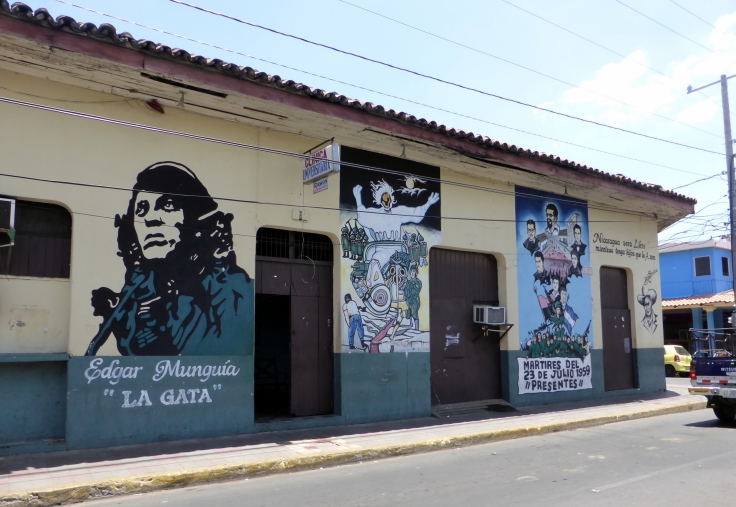
After spending a week in Granada I took a shuttle, which basically is a small van transporting tourists, to the city of Leon, which is another colonial town in Nicaragua. Lonely Planet describes it as an off-beat, political town and a more left-leaning and quirky rival to Granada. The distance between the two cities is no more than 120 kilometres, yet it took us half the day to reach our destination. Upon arrival, I was yet again underwhelmed, as Leon even looks shabbier than Granada. Despite it not being love at first, or even second, sight, I stayed in the city for more than a week and the place did start to grow on me.
Dutchies Galore
I was taken by surprise by how many Dutchies I met in town as both residents and traveller- tourists. In the almost three months I spent in southern and eastern Mexico, I could count the Dutchies I had come across on the fingers of one hand and wondered where they were all hiding. “In Nicaragua” might have been the answer, as on average I met a bit less than a handful of fellow and sister Lowlands People everyday. Norwegian travellers, in my experience a rather invisible travelling force, were also well presented in town. Like Granada, Leon has a shed load of churches to find salvation or refuge from the rain or heat and pleasant cafes and eateries to set up office.
Leon and its Place in History
The city was founded in 1525 about 33 km to the east of its current location. In 1620 the city was damaged by earthquakes caused by seismic activity from nearby volcanos and the Spanish invaders, who lived in the city decided to relocate the settlement to its present location. The old city was slowly covered by ash and other volcanic sediment from several volcanic eruptions and was only discovered in the late 1960s.
Leon had been the capital of Nicaragua since the arrival of Spanish greedy bastards and remained the capital when Nicaragua became an independent nation in 1839. In the first decade after independence the capital shifted between Leon and Granada with more conservative administrations favouring the latter and liberal rulers giving the preference to Leon. As a compromise, neutral Managua was chosen as the capital of the young nation in 1852.
When I was growing up Nicaragua was synonymous with dictatorship, revolutions and civil war. Besides that, air travel and therefore travel outside Europe was considered terribly exotic and a rather distant dream for most and the only people, who would consider travelling to Nicaragua, were war journalists. Nowadays, tourists numbers in the country have been increasing year by year and for most travellers, the civil war is just a history lesson, if the awareness is there at all. For decades Leon has been the epicentre of political left-winged activity and a fair amount of, mainly mature, travellers, are interested in the city, because of its prominent role in the revolution. Because of its left-leaning inclination, Leon always had strong links to the Sandinista movement, that formed the main opposition to the Somoza dictatorship in the 1960s and 1970s, which led to the toppling of the regime in 1979. If the revolution to overthrow the dictatorship wasn’t bloody enough, the Contra war, that followed, brought extended suffering to Nicaragua, claiming tens of thousands of lives. This Contra war was waged by Sandinistas and by US-sponsored right-winged opposition groups and made Nicaragua a major proxy war battleground during the Cold War.
Leon; the Verdict
Leon still carries its revolutionary colours with pride and the city has a museum dedicated to this turbulent episode in history. Besides political, the city is also very intellectual and is, as one can imagine, a major student town. Alongside the politics and the intellectualism, the city does literature quite well too, as it has been home to the country’s most well-known poets Rubén Dario, Salamón de Selva and Alfonso Cortéz, and still houses a great number of bookshops.
Although, as stated earlier, the city grew on me in the course of the days, despite a rich culture and plenty of good and very affordable eateries, I just wasn’t able to catch the vibe. Would I recommend visiting Leon? If you are interested in churches, Nicaraguan recent history and the revolution in particular, then yes, definitely; go. Would you like an urban base to visit the many volcanoes in the region and the nearby beaches, whether you go for the deserted beach of Salinas Grandes or the closer by playas las Peñitas and Poneloya, then yes, consider it. If you are expecting a ‘cool’ Latin city like Medellin or Panama City, which are both considerably bigger, or even Xela in Guatemala, which is more or less the same size, than just forget it. Although I will report on Panama City’s in a few weeks’ time, perhaps Central America is just not so much about cool ondas urbanas.

Leave a comment